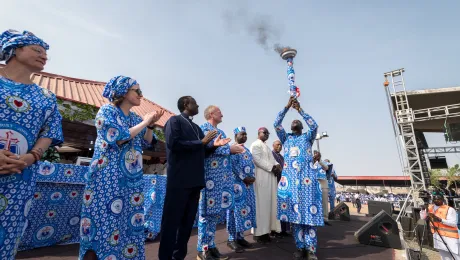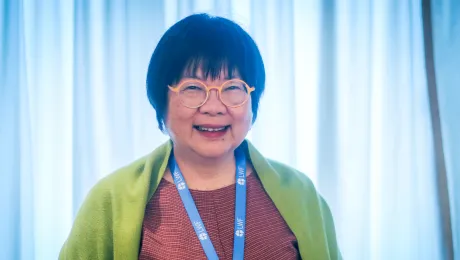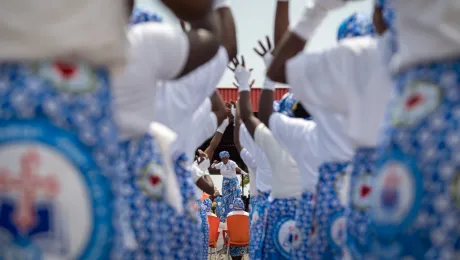
Students celebrate the return of exiled SWAPO leader Sam Nujoma on 14 September 1989
The Namibian churches and the LWF played a vital role during Namibia’s struggle for independence. Under South African rule, the policy was to divide people along racial and tribal lines. The churches were virtually the only organizations that brought people together inside Namibia. It was largely through the church that black Namibians could have access to education, health care, human dignity and democratic decision-making. The church also gave black Namibians contact with the world at large.
The LWF walked in solidarity with the Namibians through humanitarian assistance for refugees, project support for the churches, scholarships, and extensive advocacy. It is fair to say that the UN transitional peace plan could not have succeeded without the active support and cooperation of the church. Given the LWF’s long and strong links with Namibia and Namibian refugees, it was no surprise that UNHCR and the Namibian churches asked the LWF to have a role in the repatriation of refugees. A part of UN Resolution 435 called for Namibian refugees to return home in time to be able to participate in the transition process and vote in the elections.
The Council of Churches in Namibia (CCN) had overall responsibility for implementing the Repatriation, Resettlement and Reconstruction (RRR) program. LWF World Service provided financial and technical support, particularly in the areas of administrative and financial systems, design and construction of refugee reception centers, and distribution of food and supplies to resettled refugees. The repatriation operation in 1989 was a great success, with more than 41,000 Namibians able to return home in safety and dignity.
The following photos were taken during the year prior to Namibian independence on 21 March 1990.

Oshiwambo mothers watch South African soldiers driving towards Ondangwa, northern Namibia. Namibia’s year of transition to independence went from April 1989 to March 1990. During that time the United Nations Transitional Assistance Group (UNTAG) was deployed and South Africa gradually withdrew, first militarily and then administratively. Source: Ralston Deffenbaugh, “The LWF and Namibia”, 2017. Photo: LWF Archives/J. Liebenberg/1989

Tents erected at reception centers for returnees. In April 1989, the UNHCR and its local implementing partner, the Council of Churches in Namibia (CCN), appointed LWF World Service to provide technical support for the Repatriation, Resettlement and Reconstruction (RRR) program. The LWF helped set up reception centers for returnees. Those at Engela and Ongwediva received and processed nearly 24,000 returnees. Photo: WCC/Helmut Reuschle

Returnees leave the Ongwediva reception centre for their homes in northern Namibia carrying household possessions. Source: DWS Namibia reports, 1989. Photo: WCC Photo/D. Edkins/1989

Namibian returnees haul their cases and boxes as they leave Ongwediva reception center in northern Namibia to go back home. Source: DWS Namibia reports, 1989. Photo: UNHCR/19004/J. Zaprzala/06.1989

Over 10,000 Namibians make their way to Windhoek airport to welcome the SWAPO (South West Africa People’s Organisation) leader, Sam Nujoma, after 30 years of exile, on 14 September 1989. His return was part of the country’s year-long return to independence. Upon independence on 21 March 1990, Nujoma became Namibia’s first President. Photo: WCC/D. Edkins/1989

Namibian National Students Organisation members celebrate exiled SWAPO leader Sam Nujoma’s return from exile on 14 September 1989. His return was part of Namibia’s year-long return to independence. The liberation movement leader and politician would serve three terms as the first President of Namibia, from 1990 to 2005. Photo: WCC/D. Edkins/1989

SWAPO President Sam Nujoma, with LWF General Secretary Rev. Dr Gunnar Stålsett at the Ecumenical Centre, Geneva, in 1987. Photo: LWF/P. Williams
The Twelfth Assembly will be held in Windhoek, Namibia, 10-16 May 2017. Around 800 participants are expected at the event that will include a commemoration of the 500 years of the Reformation. The Assembly is LWF’s highest-decision making body, convening delegates from all the member churches every six to seven years. The Eleventh Assembly was held in July 2010 in Württemberg, Germany. Prior to the Assembly four regional Pre-Assemblies will be held in Bangkok, Thailand; Paramaribo, Suriname; Malmö, Sweden; and in Johannesburg, South Africa.


